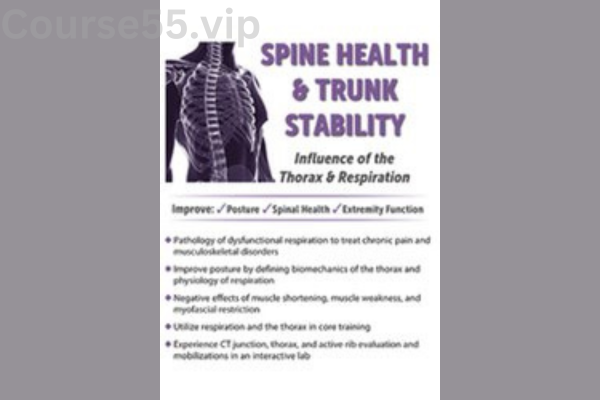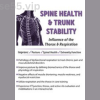Spine Health & Trunk Stability: Influence of the Thorax & Respiration By Debra Dent
$249.00 Original price was: $249.00.$23.10Current price is: $23.10.
Spine health & trunk stability: Influence of the thorax & respiration by Debra Dent – Digital Download!

Spine Health & Trunk Stability: Influence of the Thorax & Respiration By Debra Dent
Overview

Spine Health & Trunk Stability: The Role of the Thorax and Respiration – Insights from Debra Dent
In the field of musculoskeletal health, the relationship between the thorax, respiration, and spinal stability is essential for efficient movement and overall well-being. Debra Dent’s work sheds light on how thoracic stability supports spinal health and trunk control, influencing mobility and rehabilitation strategies.
By understanding these interactions, practitioners can better manage conditions like lower back pain and fibromyalgia, ultimately improving patients’ quality of life. This article explores the key insights from Dent’s research, emphasizing the critical role of thoracic function, respiratory mechanics, and practical applications for rehabilitation.
The Thorax: A Dynamic Component of Trunk Stability
Far from being a passive structure, the thorax is an active player in movement and stability, facilitating trunk rotation and weight distribution between the upper and lower body. Proper thoracic function allows for smooth weight shifting, which is essential for maintaining balance and preventing falls.
Dent’s research highlights that thoracic stability directly enhances axial rotation, improving an individual’s ability to bend, twist, and shift efficiently in daily activities.
The Rib Cage’s Contribution to Spinal Stability
Scientific findings show that the rib cage plays a significant role in stabilizing the thoracic spine, offering several benefits:
- Reduced Spinal Range of Motion – Limiting excessive motion helps prevent injury.
- Lower Neutral Zones – Creating a more controlled and stable spinal position.
- Decreased Intradiscal Pressures – Reducing stress on spinal discs.
- Increased Spinal Stiffness – Enhancing resistance to compressive forces.
These biomechanical benefits reinforce why strengthening the thoracic region is vital for pain relief and improved movement. Targeted interventions that focus on thoracic function can significantly enhance spinal health and overall mobility.
The Diaphragm’s Role in Spinal Stabilization
A crucial yet often overlooked aspect of spinal stability is the diaphragm’s function in respiration. Dent’s work reveals that dysfunctional breathing patterns can negatively impact thoracic stability and trunk control, leading to poor movement quality and increased injury risk.
Key Ways the Diaphragm Supports Spinal Stability
- Core Activation – The diaphragm’s contraction activates deep core muscles, improving spinal support.
- Pressure Regulation – Diaphragmatic movement influences intra-abdominal pressure, a key factor in stabilizing the spine.
- Postural Control – Efficient breathing mechanics promote better posture and spinal alignment, reducing strain on the musculoskeletal system.
Given these relationships, incorporating diaphragmatic breathing exercises into rehabilitation programs can enhance trunk stability and pain management, particularly for those dealing with chronic pain, neck discomfort, or lower back issues.
Practical Applications for Various Patient Populations
Dent’s insights offer valuable guidance for clinicians in addressing a range of conditions, from chronic pain to mobility restrictions. By recognizing the thorax’s role in spinal health, practitioners can develop holistic treatment strategies that integrate both respiratory function and spinal stability.
For example, patients with chronic pain often limit movement due to fear of worsening their symptoms. However, incorporating thoracic mobility drills and breathing techniques into therapy can create a sense of security and improved functional movement.
Therapeutic Interventions for Improved Trunk Stability
- Breathing Exercises – Guided diaphragmatic breathing to enhance lung function and spinal support.
- Postural Training – Exercises focusing on thoracic extension and rotation to align the spine correctly.
- Mobility Drills – Targeted movements that improve trunk coordination and integration of upper and lower body mechanics.
By implementing these practices, physical therapists and healthcare professionals can offer more comprehensive care, addressing both structural and functional aspects of musculoskeletal health.
Conclusion: A Holistic Approach to Spinal Health
Debra Dent’s research highlights the profound impact of thoracic stability and respiratory function on spinal health. Her findings emphasize the need for a multidisciplinary approach in rehabilitation, integrating thoracic mobility, diaphragmatic breathing, and targeted stability exercises.
As healthcare continues to evolve, recognizing these interconnected systems will be crucial for enhancing patient outcomes. By optimizing thoracic function and respiration, clinicians can implement more effective treatment strategies, ultimately helping individuals achieve better mobility, reduced pain, and improved quality of life.
Dent’s evidence-based insights provide a strong foundation for refining therapeutic practices, ensuring that individuals with musculoskeletal challenges receive the most effective and comprehensive care possible.
Frequently Asked Questions:
Business Model Innovation: We operate a group buying strategy, allowing participants to share costs and access popular courses at reduced prices. This model benefits individuals with limited financial resources, despite concerns from content creators about distribution methods.
Legal Considerations: The legality of our operations involves complex issues. Although we don’t have explicit permission from course creators to resell their content, there are no specific resale restrictions stated at the time of purchase. This ambiguity creates an opportunity for us to provide affordable educational resources.
Quality Control: We ensure that all course materials purchased are identical to those offered directly by the creators. However, it’s important to understand that we are not official providers. As such, our offerings do not include:
– Live coaching calls or sessions with the course author.
– Access to exclusive author-controlled groups or portals.
– Membership in private forums.
– Direct email support from the author or their team.
We aim to reduce the cost barrier in education by offering these courses independently, without the premium services available through official channels. We appreciate your understanding of our unique approach.
Be the first to review “Spine Health & Trunk Stability: Influence of the Thorax & Respiration By Debra Dent” Cancel reply
You must be logged in to post a review.

















Reviews
There are no reviews yet.